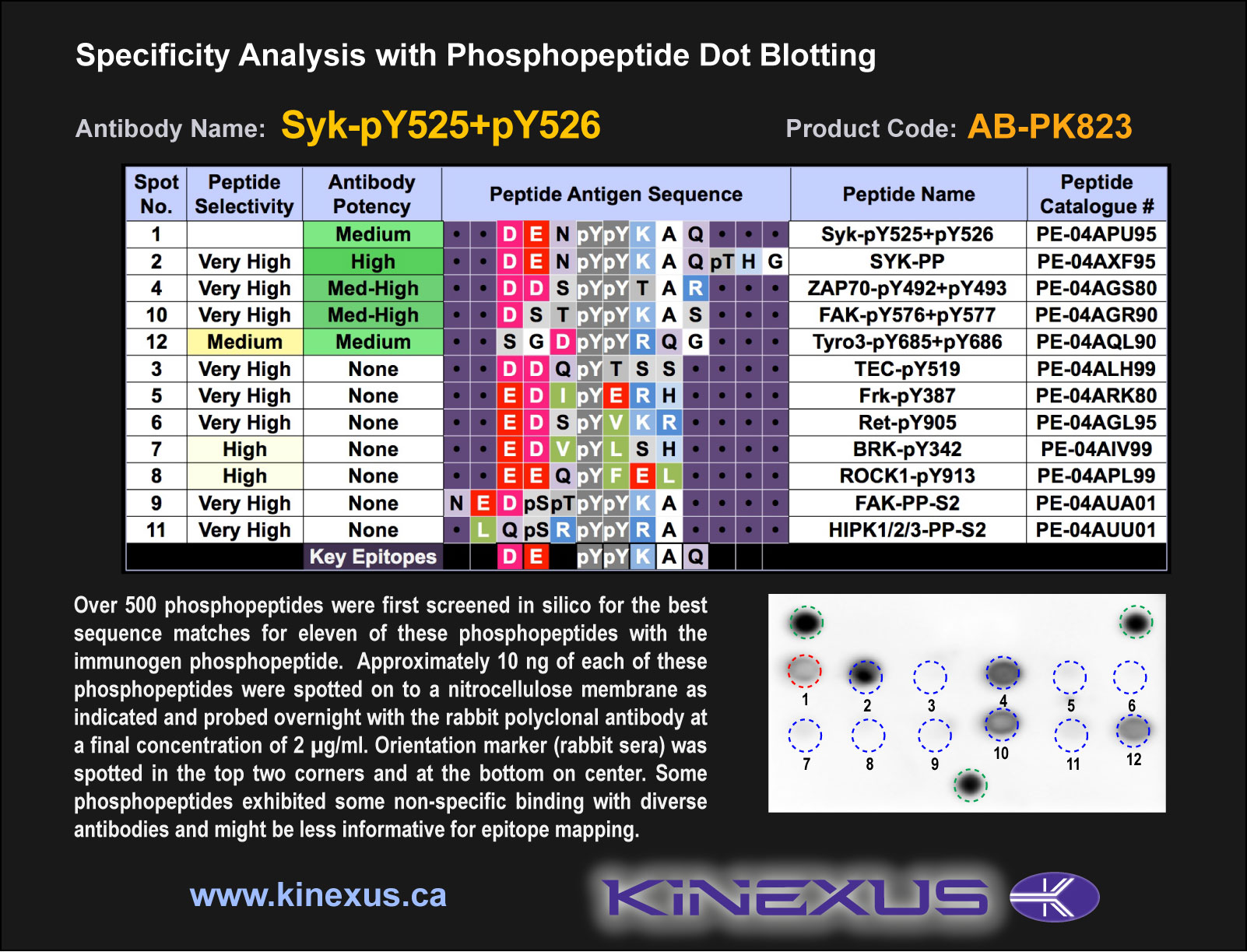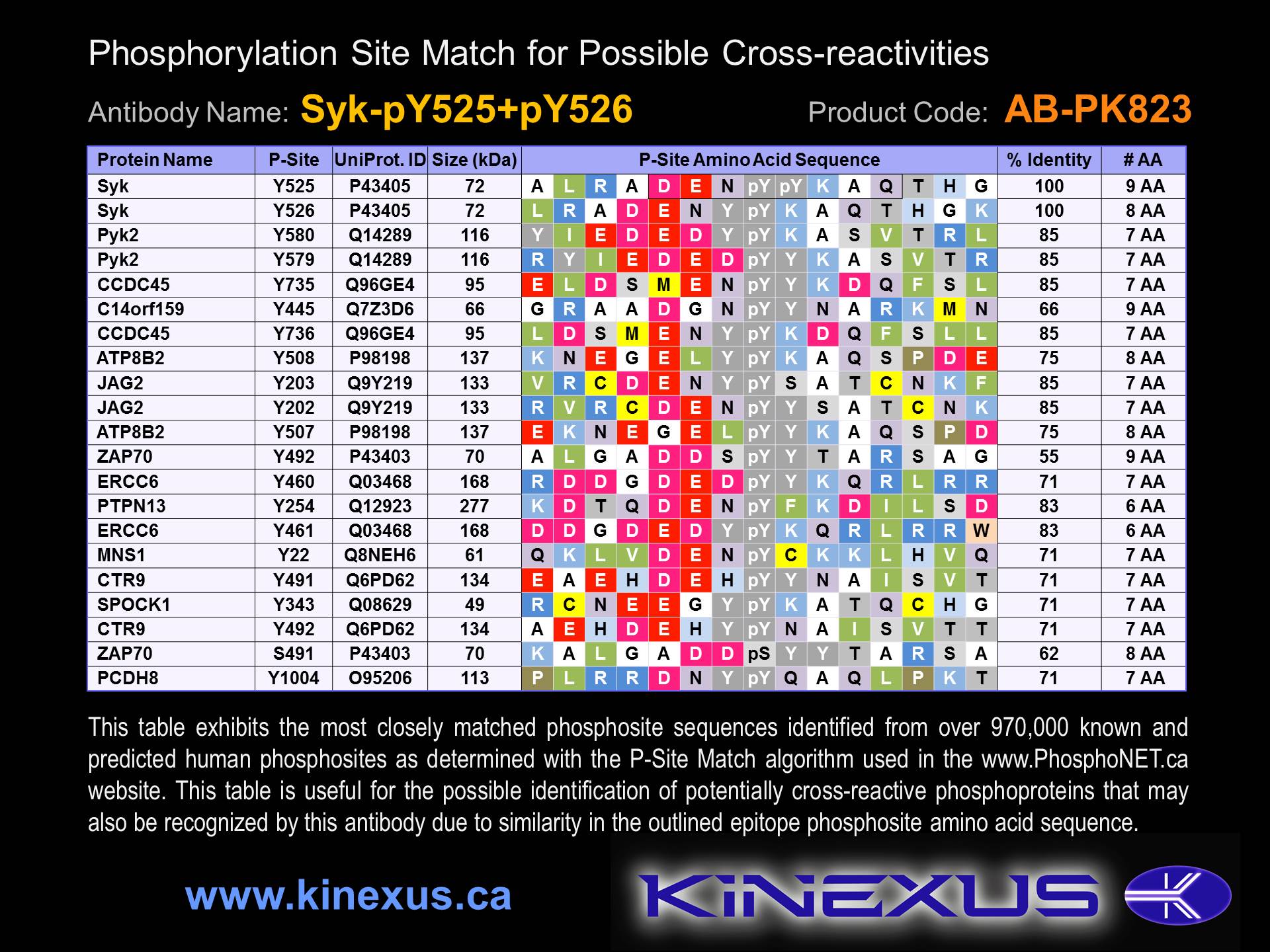Product Name: Syk-pY525+pY526
Product Number: AB-PK823
| Size: | 25 µg | Price: | 89.00 | |
| $US |
Target Full Name: Spleen protein-tyrosine kinase
Target Alias: DKFZp313N1010; FLJ25043; FLJ37489; Kinase Syk; KSyk; Spleen tyrosine kinase; Syk; CCDS6688.1; ENSG00000165025
Product Type Specific: Protein kinase phosphosite-specific antibody
Antibody Code: PK823
Antibody Target Type: Phosphosite-specific
Antibody Phosphosite: Y525+Y526
Protein UniProt: P43405
Protein SigNET: P43405
Antibody Type: Polyclonal
Antibody Host Species: Rabbit
Target Alias: DKFZp313N1010; FLJ25043; FLJ37489; Kinase Syk; KSyk; Spleen tyrosine kinase; Syk; CCDS6688.1; ENSG00000165025
Product Type Specific: Protein kinase phosphosite-specific antibody
Antibody Code: PK823
Antibody Target Type: Phosphosite-specific
Antibody Phosphosite: Y525+Y526
Protein UniProt: P43405
Protein SigNET: P43405
Antibody Type: Polyclonal
Antibody Host Species: Rabbit
Antibody Immunogen Source: Human Syk sequence peptide Cat. No.: PE-04APU95
Antibody Immunogen Sequence: DEN(pY)(pY)KAQ(bA)C
Antibody Immunogen Description: Corresponds to amino acid residues D522 to Q529; In protein kinase catalytic domain activation T-loop between subdomains VII and VIII.
Antibody Immunogen Sequence: DEN(pY)(pY)KAQ(bA)C
Antibody Immunogen Description: Corresponds to amino acid residues D522 to Q529; In protein kinase catalytic domain activation T-loop between subdomains VII and VIII.
Production Method: The immunizing peptide was produced by solid phase synthesis on a multipep peptide synthesizer and purified by reverse-phase hplc chromatography. Purity was assessed by analytical hplc and the amino acid sequence confirmed by mass spectrometry analysis. This peptide was coupled to KLH prior to immunization into rabbits. New Zealand White rabbits were subcutaneously injected with KLH-coupled immunizing peptide every 4 weeks for 4 months. The sera from these animals was applied onto an agarose column to which the immunogen peptide was thio-linked. Antibody was eluted from the column with 0.1 M glycine, pH 2.5. Subsequently, the antibody solution was neutralized to pH 7.0 with saturated Tris.This antibody was also subject to negative purification over phosphotyrosine-agarose.
Antibody Modification: Unconjugated. Contact KInexus if you are interest in having the antibody biotinylated or coupled with fluorescent dyes.
Antibody Modification: Unconjugated. Contact KInexus if you are interest in having the antibody biotinylated or coupled with fluorescent dyes.
Antibody Concentration: 1 mg/ml
Storage Buffer: Phosphate buffered saline pH 7.4, 0.05% Thimerasol
Storage Conditions: For long term storage, keep frozen at -40°C or lower. Stock solution can be kept at +4°C for more than 3 months. Avoid repeated freeze-thaw cycles.
Product Use: Western blotting | Antibody microarray
Antibody Dilution Recommended: 2 µg/ml for immunoblotting
Antibody Potency: Medium immunoreactivity of a target-sized protein by Western blotting in HeLa cells. Medium immunoreactivity with immunogen peptide on dot blots.
Antibody Species Reactivity: Human
Storage Buffer: Phosphate buffered saline pH 7.4, 0.05% Thimerasol
Storage Conditions: For long term storage, keep frozen at -40°C or lower. Stock solution can be kept at +4°C for more than 3 months. Avoid repeated freeze-thaw cycles.
Product Use: Western blotting | Antibody microarray
Antibody Dilution Recommended: 2 µg/ml for immunoblotting
Antibody Potency: Medium immunoreactivity of a target-sized protein by Western blotting in HeLa cells. Medium immunoreactivity with immunogen peptide on dot blots.
Antibody Species Reactivity: Human
Antibody Positive Control: The observed molecular mass of the processed target protein on SDS-PAGE gels is reported to be around 67-77 kDa.
Antibody Specificity: High-very high
Antibody Cross Reactivity: Almost no significant cross-reactivities detected in A HeLa, MCF7, Jurkat and T98G cells, but very strong cross-reactive 75 and 78 kDa proteins in HeLa cells.
Related Product 1: Syk-pY525+pY526 blocking peptide
Related Product 2: Syk-pY323 phosphosite-specific antibody (Cat. No.: AB-PK821)
Related Product 3: SykSubtide - Syk protein kinase substrate peptide
Antibody Specificity: High-very high
Antibody Cross Reactivity: Almost no significant cross-reactivities detected in A HeLa, MCF7, Jurkat and T98G cells, but very strong cross-reactive 75 and 78 kDa proteins in HeLa cells.
Related Product 1: Syk-pY525+pY526 blocking peptide
Related Product 2: Syk-pY323 phosphosite-specific antibody (Cat. No.: AB-PK821)
Related Product 3: SykSubtide - Syk protein kinase substrate peptide
Scientific Background: Syk is one of several protein kinases that can phosphorylate KinSub4DDDYV. Syk is a protein-tyrosine kinase that is a member of the TK group of protein kinases in the Syk family. It is moderate to highly expressed in most tested human tissues, particularly in hematopoietic cells. It mediates cell proliferation, differentiation, and phagocytosis. In B cells, Syk plays a crucial role in intracellular signalling induced by oxidative stress as well as antigen receptor engagement. Syk is activated by phosphorylation at Y525 and Y526. Phosphorylation of Y348 and Y352 enhances the binding, phosphorylation and activation of PLC-gamma and the early phase of Ca(2+) mobilization via a PI 3-kinase-independent pathway. Phosphorylation of Y131 of Syk inhibits interaction with Bcr. Phosphorylation of Y323 of Syk inhibits B cell Ag receptor signalling and strongly dampens the Ca(2+) signal. Syk appears to be an oncoprotein (OP) and a tumour suppressor protein (TSP). Syk is an oncoprotein in retinoblastoma, which is upregulated and is required for tumour cell survival. Syk is a potential tumour suppressor in breast cancer, where it absence in primary breast tumours is correlated with poor outcomes. Syk deficient cells have increased motility that is restored to normalcy by replacement with wild-type Syk. It has been linked with the development of allergy, asthma, inflammation, gastric cancer, acute lymphoblastic leukemia, and acute myeloid leukemia.
Figure 1. Epitope mapping of Syk-pY525+pY526 antibody with similar phosphopeptides on dot blots.
Figure 2. Identification of phosphosites related to Syk-pY525+pY526.
© Kinexus Bioinformatics Corporation 2017



